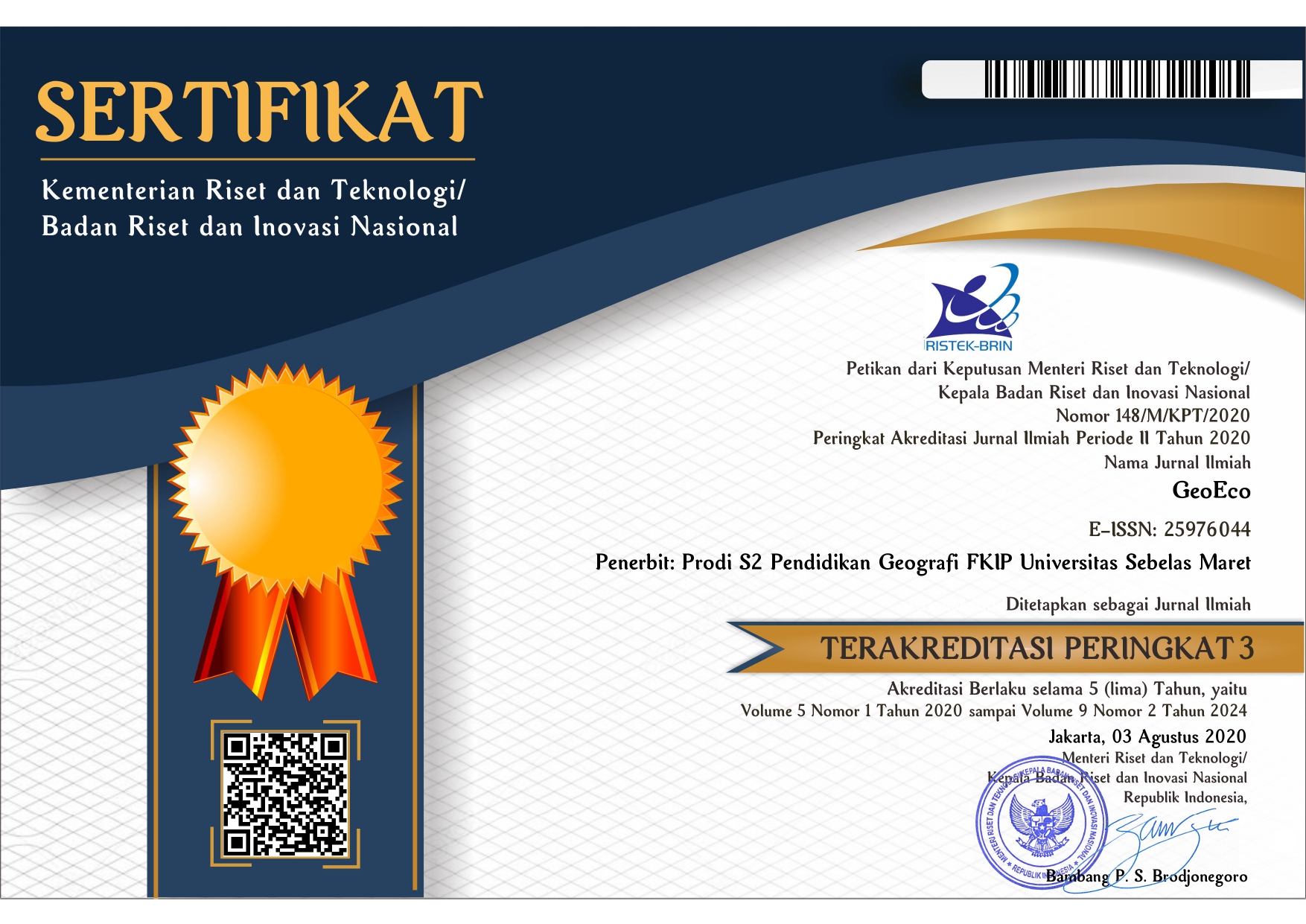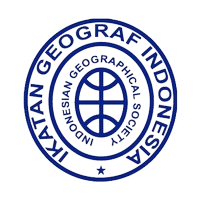CHARACTERISTICS OF DUWET KARST SPRING BASED ON BASEFLOW INDEX ASSESSMENT AND ITS POTENTIAL IN FRESH WATER SUPPLY
Abstract
This study aims to determine the potential of Duwet springs and their availability for supplying fresh water to the surrounding community. we use hydrographs to analyze aquifer characteristics. To analyze the hydrographs, we use water level and spring discharge data. Automatic Water Level Record (AWLR) records water level data for 1 dry season and 1 rainy season every 15 minutes. We use the volumetric method to measure the spring discharge 14 times. We compare the base flow and demand over a year to analyze the potential for fresh water. The results show that the Stage discharge rating curve y = 0.0002e5,453x with R² value of 0.87. Duwet Springs is a perennial spring that has a small discharge (class VI). The largest discharge ever recorded was 0.69 L/s (March 7, 2020) and the smallest recorded was 0.12 L/s (August 21, 2020). BFI value varied between 0.05 and 1 with mean 0.801. The total base flow is 2490675.734 L (rainy season) and 1563419.873 L (dry season). These springs are sufficient for 75% of the rainy season and 84% in the dry season. This indicates that the existence of Duwet springs is very important for the surrounding community.
Keywords
Full Text:
PDFReferences
Adji, T. N., & Haryono, E. (2004). Geomorfologi dan Hidrologi Karst. Adji, T. N., & Haryono, E. (2017). Konflik Antara Pemanfaatan Batugamping Dan Konservasi Sumberdaya Air Das Bribin Di Wilayah Karst Gunung Sewu. Makalah Lokakarya Nasional Menuju Pengelolaan Sumberdaya Wilayah Berbasis Ekosistem Untuk Mereduksi Konflik Antar Daerah. https://doi.org/10.31219/osf.io/utsxz Andreo, B., Carrasco, F., Duran, J. J., & LaMoreaux, J. W. (2010). Advances in Research in Karts Media. In Environmental Earth Sciences. Spinger. https://doi.org/10.1007/978-3-642-12486-0_61 Bakalowicz, M. (2005). Karst groundwater: A challenge for new resources. Hydrogeology Journal, 13(1), 148–160. https://doi.org/10.1007/s10040-004-0402-9 Balazs, D. (1971). Intensity of The Tropical Karst Based on Cases of Indonesia. Budapest, 33–67. Bemmelen, V. (1949). The Geology of Indonesia. The Haque. Bonacci, O. (2009). Karst springs hydrographs as indicators of karst aquifers. Hydrological Sciences Journal, 38(1), 51–62. https://doi.org/10.1080/02626669309492639 Chapman, T. G. (1991). Comment on “Evaluation of automated techniques for base flow and recession analyses” by R. J. Nathan and T. A. McMahon. Water Resources Research, 27(7), 1783–1784. https://doi.org/10.1029/91WR01007 Eckhardt, K. (2005). How to construct recursive digital filters for baseflow separation. Hydrological Processes, 19(2), 507–515. https://doi.org/10.1002/hyp.5675 Fetter, C. W. (1994). Applied Hydrogeology. Waveland Press. Ford, D., & Williams, P. (2007). Karst Hydrogeology and Geomorphology. Wiley & Sons. Gillieson, D. S. (2011). Management of Caves. In Karst Management (Issue June 2011, pp. 141–158). Spinger. https://doi.org/10.1007/978-94-007-1207-2 Goldscheider, N., Chen, Z., Auler, A. S., Bakalowicz, M., Broda, S., Drew, D., Hartmann, J., Jiang, G., Moosdorf, N., Stevanovic, Z., & Veni, G. (2020). Global distribution of carbonate rocks and karst water resources. Hydrogeology Journal, 28(5), 1661–1677. https://doi.org/10.1007/s10040-020-02139-5 Gunn, J. (1985). A conceptual model for conduit flow dominated karst aquifers. In: “Karst Water Resources.” Proc. Ankara Symposium, 587–596. Haryono, E. (2001). Nilai Hidrologis Bukit Karst. Seminar Eko-Hidrolik. Jennings. (1971). Karst Geomorphology. Brasil Blackwell Inc. Lyne, V., & Hollick, M. (1979). Stochastic Time-Variable Rainfall-Runoff Modelling. Institute of Engineers Australia National Conference, 89–93. Manga, M. (1999). On the timescales characterizing groundwater discharge at springs. Journal of Hydrology, 219, 56–69. https://doi.org/10.1016/S0022-1694(99)00044-X Nathan, R. J., & McMahon, T. A. (1990). Evaluation of automated techniques for base flow and recession analyses. Water Resources Research, 26(7), 1465–1473. https://doi.org/10.1029/WR026i007p01465 Padilla, A., Pulido-Bosch, A., & Mangin, A. (1994). Relative Importance of Baseflow and Quickflow from Hydrographs of Karst Spring. Ground Water, 32(2). Palmer, A. N. (1999). Patterns of Dissolution Porosity in Carbonate Rocks. In Karst Waters Institute Special Publication 5. Karst Waters Institute, Inc. Stevanović, Z. (2019). Karst waters in potable water supply: a global scale overview. Environmental Earth Sciences, 78(23), 1–12. https://doi.org/10.1007/s12665-019-8670-9 Sudarmadji, Suprayogi, S., & Setiadi. (2012). Konservasi Springs Berbasis Masyarakat di Kabupaten Gunungkidul. Universitas Gadjah Mada. Surono, T. B., Sudarno, I., & Wiryosujono, S. (1992). Geologi Lembar Surakarta-Giritontro, Jawa. Sweeting, M. M. (1972). Karst Landforms. Micmilland. Syahidin, U. (2016). Analisis Potensi Mata Air Karst untuk Kebutuhan Air Domestik Penduduk Desa Basuhan Kecamatan Eromoko Kabupaten Wonogiri. Universitas Muhammadiyah Surakarta. Waltham, A. C., Smart, P. L., Friederich, H., Eavis, A. J., & Atkinson, T. C. (1983). The Caves of Gunung Sewu. Cave Sci, 10, 55–96. White, W B. (1993). Analysis of Karst Aquifer. Van Nostrand Reinhold. White, William B. (2002). Karst hydrology: Recent developments and open questions. Engineering Geology, 65(2–3), 85–105. https://doi.org/10.1016/S0013-7952(01)00116-8 Wijayanti, P., Noviani, R., & Tjahjono, G. A. (2015). Dampak Perubahan Iklim Terhadap Imbangan Air Secara Meteorologisdengan Menggunakan Metode Thornthwaite Mather Untuk Analisiskekritisan Air Di Karst Wonogiri. Geomedia: Majalah Ilmiah Dan Informasi Kegeografian, 13(1), 27–40. https://doi.org/10.21831/gm.v13i1.4475
Refbacks
- There are currently no refbacks.












.png)

